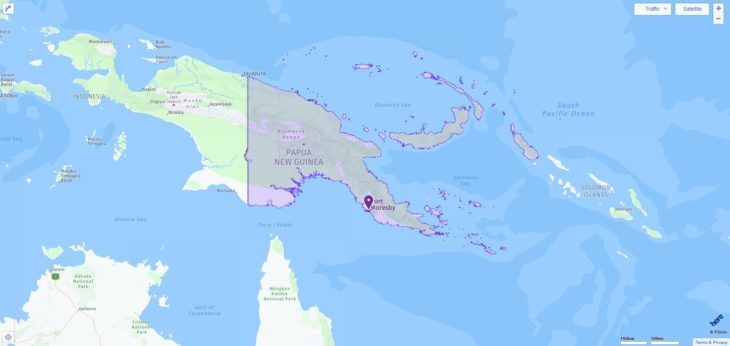Your search found 1 match. The following is the full list of ACT testing locations in Papua New Guinea among which you can pick one to take the exam. Please know that on the test day, test takers can use any 4-function, scientific, or graphing calculator. On the table below, you can also find all test dates through 2019.

2019-2020 ACT Test Dates in Papua New Guinea
| Test Date | Registration Deadline |
| February 9, 2019 | January 11, 2019 |
| April 13, 2019 | March 8, 2019 |
| June 8, 2019 | May 3, 2019 |
| July 13, 2019 | June 14, 2019 |
| September 14, 2019 | August 16, 2019 |
| October 26, 2019 | September 20, 2019 |
| December 14, 2019 | November 8, 2019 |
| February 8, 2020 | January 10, 2020 |
| April 4, 2020 | February 28, 2020 |
| June 13, 2020 | May 8, 2020 |
| July 18, 2020 | June 19, 2020 |
ACT Test Centers in Papua New Guinea
| City | Center Name | Center Code |
| Ukarumpa Ehp | Ukarumpa Intl Sch-Secondary | 867270 |
Population
The majority of the population consists of Papua, who use over 700 different languages (Papua) and about 90% live in the impassable mountainous country of New Guinea. In addition to the ethnic groups and tribes, which are largely still based on traditional lifestyles, there is a small population group that is oriented towards the western lifestyle and lives in the cities.
Melanesians in particular, as well as minorities of Micronesians and Polynesians, settle near the coast and on the islands. Many foreigners (Chinese, Indonesians, Australians) are active in administration, education, trade and industry. The share of the urban population was only 13% in 2017. Most people live in villages with a few hundred residents. With an average of 18 residents / km 2, Papua New Guinea is very sparsely populated. While some high valleys, coastal areas and various islands have a population density of up to 200 residents / km 2, large areas are almost deserted.
Social: Social and health services are in the process of being established and are still inadequate, especially in rural areas.
The biggest cities in Papua New Guinea
| Biggest Cities (Residents 2011) | |
| Port Moresby | 364 100 |
| Lae | 148 900 |
| Wewak | 37 800 |
| Madang | 36,000 |
| Mount Hagen | 29 800 |
The peoples of Papua New Guinea
The peoples of Papua New Guinea
Over 700 different languages are spoken in Papua New Guinea; it is thus the country with the greatest linguistic wealth. This linguistic diversity suggests that the individual ethnic groups have lived in their respective areas for a very long time and have lived very isolated. The coast and offshore islands, on the other hand, were settled by Melanesian-speaking groups relatively recently.
A characteristic of the cultures of Papua New Guinea is an ideal of equality, in which individuals are judged on the performance that gives them prestige. The “Big Man” identified in this way have special authority within small groups. Frequent armed conflicts, the ceremonial exchange of objects between groups (similar to the kula on the islands east of Papua New Guinea) and the display of wealth, e.g. B. on the occasion of large pig festivals, are significant in this context. In order to gain prestige, goods and wealth must not only be accumulated, but also passed on or consumed. The basis of the social structure is the clan, whose members are related to one another through a common mythological ancestor.
The 1,126 km long Sepik is New Guinea’s most important river and a trade route that has been used for centuries. The peoples of the middle Sepik (e.g. Iatmül, Kwoma, Abelam in the Sepik hill country) are known for their impressive architecture, especially long houses used for ceremonies, and idiosyncratic artistic styles. The art was originally of purely religious importance and was associated with elaborate initiation rites, in which mask dances, sacred musical instruments, etc. played a special role. Meanwhile, masks and other carvings made for tourists have become an important source of income.
The arrival of the Europeans, the spread of money and the penetration of modern goods into the everyday life of the residents led to a profound change in the traditional cultures of Papua New Guinea. People’s irritation in the face of these innovations and their desire to find their way around the new situation found a dramatic expression in the cargo cults. These religious movements heralded the arrival of great ancestral riches on European ships.
Religion
The constitution guarantees religious freedom and formulates in the preamble the obligation of the state to follow “the venerable traditions and Christian principles that are our own”.
According to the 2011 census (last available official data), around 96% of the population are Christians: the majority of them belong to Protestant denominations (especially Lutherans [18.4%], Pentecostals [10.4%], United Church in Papua New Guinea [10, 3%], Evangelical Alliance [5.9%]), in addition to 26% of the Catholic Church and 3.2% of the Anglican Church. Adventists have a population of 12.9%. In addition, there are smaller independent churches that incorporate traditional customs and ideas into the Christian life of faith. The Catholic Church comprises four archdioceses (Madang, Mount Hagen, Port Moresby, Rabaul) with 15 suffragan dioceses; the Anglican Church of the Province of Papua New Guinea has five dioceses. The Bahais are a non-Christian religious minority. Cargo cults are of local importance.

